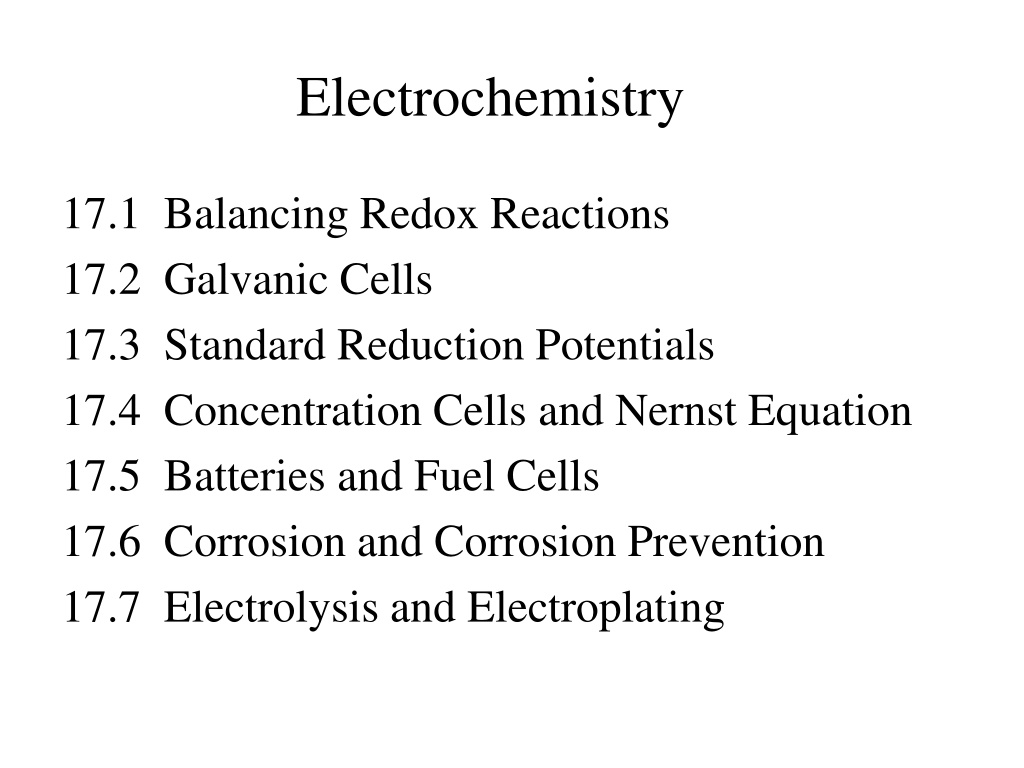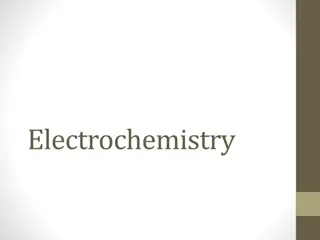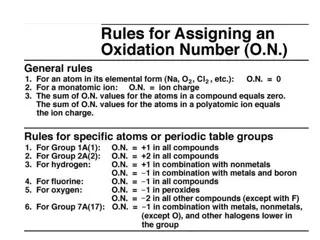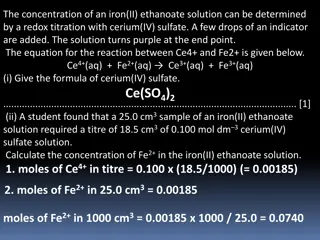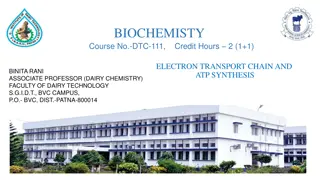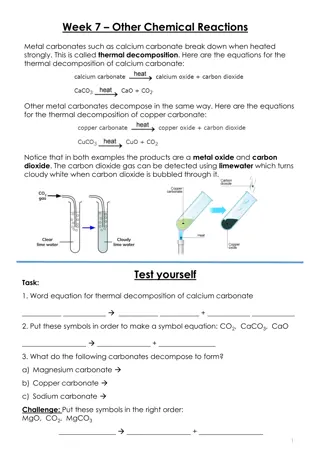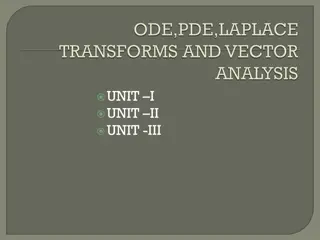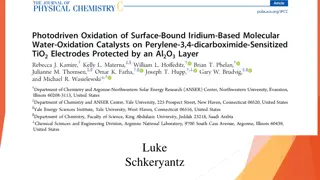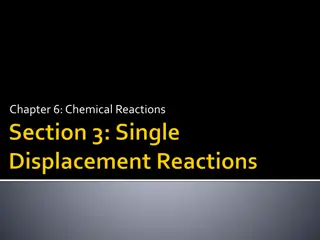Understanding Electrochemistry: Redox Reactions, Cells, and Equations
Electrochemistry is a branch of chemistry that involves redox reactions, galvanic cells, standard reduction potentials, balancing redox equations, batteries, corrosion prevention, and electrolysis. Learn about the fundamental principles, examples of redox reactions, and how to balance equations using the half-reaction method in this comprehensive guide.
Download Presentation

Please find below an Image/Link to download the presentation.
The content on the website is provided AS IS for your information and personal use only. It may not be sold, licensed, or shared on other websites without obtaining consent from the author. Download presentation by click this link. If you encounter any issues during the download, it is possible that the publisher has removed the file from their server.
E N D
Presentation Transcript
Electrochemistry 17.1 Balancing Redox Reactions 17.2 Galvanic Cells 17.3 Standard Reduction Potentials 17.4 Concentration Cells and Nernst Equation 17.5 Batteries and Fuel Cells 17.6 Corrosion and Corrosion Prevention 17.7 Electrolysis and Electroplating
Oxidation-Reduction (Redox) Reactions Review of Terms: Oxidation reduction (redox) reactions involves transfer of electrons from one reactant (the reducing agent) to another (the oxidizing agent) Oxidation the loss of electrons Reduction the gain of electrons Reducing agent electron donor Oxidizing agent electron acceptor
Redox Reactions Examples of Redox Reactions: Zn(s) + CuSO4(aq) ZnSO4(aq) + Cu(s); Zn(s) + Cu2+(aq) Zn2+(aq) + Cu(s) Cu(s) + 2AgNO3(aq) CuSO4(aq) + 2Ag(s); Cu(s) + 2Ag+(aq) Cu2+(aq) + 2Ag(s) MnO4 (aq) + 5Fe2+(aq) + 8H+(aq) Mn2+(aq) + 5Fe3+(aq) + 4H2O
Balancing Redox Equations Half Reactions Method: The overall reaction is split into two half reactions, one involving oxidation and one reduction. 8H++ MnO4-+ 5Fe2+ Mn2++ 5Fe3++ 4H2O Reduction: 8H++ MnO4-+ 5e- Mn2++ 4H2O Oxidation: 5Fe2+ 5Fe3++ 5e-
Balancing Redox Equations: The Half-Reaction Method 1. Write separate equations for oxidation and reduction half reactions. For each half reaction: Balance all the elements except H and O. Balance O using H2O. Balance H using H+. Balance the charge using electrons. If necessary, multiply one or both balanced half reactions by an integer to make the number of electrons in both half reactions equal. Add half reactions and cancel identical species. 2. 3. 4.
Balancing Redox Equations Example: balancing a redox reaction under acidic condition Cr2O72-(aq) + HSO3-(aq) Cr3+(aq) + HSO4-(aq) How can we balance this equation? First Steps: Separate into half-reactions. Balance elements except H and O.
Balancing Redox Equation: The Half-Reaction Method Cr2O72-(aq) 2Cr3+(aq) HSO3 -(aq) HSO4 -(aq) How many electrons are needed to balance the charge in each half-reaction?
Balancing Redox Equation: The Half-Reaction Method Adding electrons: Cr2O72-(aq) + 6e- 2Cr3+(aq) HSO3-(aq) HSO4-(aq) + 2e-
Balancing Redox Equation: The Half-Reaction Method Balance the oxygen atoms by adding H2O: 6e-+ Cr2O72-(aq) 2Cr3+(aq) + 7H2O H2O + HSO3-(aq) HSO42-(aq) + 2H++ 2e-
Balancing Redox Equation: The Half-Reaction Method Balance the hydrogen atoms by adding H+: (This reaction occurs in an acidic solution) 14H++ 6e-+ Cr2O72- 2Cr3++ 7H2O H2O + HSO3- HSO4-+ 2e-+ 2H+
Balancing Redox Equation: The Half-Reaction Method Balance the electrons in both half-equations: 14H++ 6e-+ Cr2O72- 2Cr3++ 7H2O 3[H2O + HSO3- HSO42-+ 2e-+ 2H+] The final balanced equation: Cr2O72-+ 3HSO3-+ 8H+ 2Cr3++ 3HSO4-+ 4H2O
Sample Exercises Balance the following redox reactions in acidic solution. 1) Br (aq) + MnO4 (aq) Br2(l) + Mn2+(aq) 2) Cr2O72-(aq) + H2O2(aq) Cr3+(aq) + H2O(l) + O2(g)
Balancing Redox Equations in Basic Solution 1. Use the half reaction method as specified for acidic solutions to obtain the final balanced equation as if H+ions were present. To both sides of the equation, add a number of OH ions that is equal to the number of H+ions present. (You want to eliminate H+by turning is into H2O) Form H2O on the side containing both H+and OH ions, and eliminate the number of H2O molecules that appear on both sides of the equation. Check that elements and charges are balanced. 2. 3. 4.
Sample Exercises Balance the following redox reactions in basic solution: Br2(aq) + OH-(aq) BrO3-(aq) + Br-(aq) + H2O; Cr(OH)4-(aq) + OH-(aq) CrO42-(aq) + H2O;
Applications of Redox Reactions Redox reactions such as combustion reactions are very exothermic they have very large negative H; Combustion reactions are primary source of energy; Redox reactions in aqueous solution also have negative H and G (free energy); Available free energy from spontaneous reactions can be trapped to produce electricity; Devices that utilize redox reactions to produce electricity are called Galvanic cells or batteries.
Electrode Potentials and Their Measurement Cu(s) + 2Ag+(aq) Cu(s) + Zn2+(aq) No reaction Cu2+(aq) + 2 Ag(s)
Terminology Galvanic cell (= electrochemical cell) A device that produces electricity from spontaneous redox reactions. Electrolytic cell: A device the uses electrical energy to make a nonspontaneous chemical reaction to occur. Electrode-couple, M|Mn+ A pair of species related by a change in the number of e-.
Galvanic Cell A device in which chemical free energy is converted to electrical energy. It uses a spontaneous redox reaction to produce a current that can be used to generate energy or to do work.
A Cu-Zn Galvanic Cell Zn(s)|Zn2+(aq)||Cu2+(aq)|Cu(s); E cell = 1.103 V
Reactions in a Galvanic Cell (??|??2+||??2+|??)
Calculating Standard Cell Potential Given the following reduction potentials: Cu2+(aq) + 2e- Cu(s); Zn2+(aq)+ 2e- Zn(s); Eo=0.34 V Eo=-0.76 V The cell potential for the following reaction is shown below. Zn(s) + Cu2+(aq) Zn2+(aq) + Cu(s); Eo cell = Eo Cu2+ |Cu Eo Zn2+ |Zn = 0.34 V ( 0.76 V) = 1.10 V
In Galvanic Cell Oxidation occurs at the anode. Reduction occurs at the cathode. Salt bridge or porous disk allows ions to flow without extensive mixing of the solutions. Salt bridge contains a strong electrolyte held in a gel like matrix. Porous disk contains tiny passages that allow hindered flow of ions.
Chemical Processes at Electrodes Anode Cathode
Electrochemical Terminologies Anode half-cell - where oxidation process occurs; Cathode half-cell - where reduction process occurs; Electricity electrons flow in the wire from the anode to the cathode half-cells; in solution, cations and anions flow in opposite directions across the salt bridge. Cell potential (Ecell) - electromotive force (emf) that drives electrons and ions to flow; aka electrical potential. The unit of electrical potential is volt (V). 1 V = 1 J/C (Joule/Coulomb of charge transferred)
Standard Electrode Potentials Cell voltage: the electrical potential difference of an electrode-pair. The cell potential of individual electrodes are measured against the Standard Hydrogen Electrode (SHE), which is reference electrode assigned an electrical potential value of 0.00 V.
Standard Hydrogen Electrode 2 H+(a = 1) + 2 e- H2(g, 1 bar) E = 0 V Pt|H2(g, 1 bar)|H+(a = 1)
Measuring Standard Reduction Potential anode cathode anode cathode
Reduction Couples E Cu2+/Cu = ? Cu2+(1M) + 2 e- Cu(s) Pt|H2(g, 1 bar)|H+(a = 1) || Cu2+(1 M)|Cu(s); E cell = 0.340 V anode cathode Standard cell potential: the potential difference of a cell formed from two standard electrodes. E cell = E cathode -E anode
Standard Cell Potential Pt|H2(g, 1 bar)|H+(a = 1) || Cu2+(1 M)|Cu(s); E cell = 0.340 V E cell = E cathode -E anode E cell = E Cu2+/Cu -E H+/H2 0.340 V = E Cu2+/Cu -0 V E Cu2+/Cu = +0.340 V H2(g, 1 atm) + Cu2+(1 M) H+(1 M) + Cu(s); E cell = 0.340 V
Standard Reduction Potentials Reduction potential, E , for other electrons are assigned positive (+) or negative (-) values, depending on whether their reduction potential is greater or smaller than the reduction potential of Hydrogen electrode under standard condition. Standard condition implies an electrolyte concentration of 1 M or gas pressure of 1 atm, and the temperature is 25 C (or 298 K)
Cell Potential of Galvanic Cell Values and algebraic sign for half-cell potentials (Eo) are given for reduction process: Mn+ + ne- M; or X2 + 2e- 2X- If the half-reaction is reversed, the algebraic sign of Eowill change, but not the value; For example: Zn2+ + 2e- Zn; Zn Zn2+ + 2e-; Standard cell potential (Eocell) of a galvanic cell is the sum of the oxidation potential of anode half-cell and the reduction potential of cathode half-cell. Eo = -0.76 V Eo = +0.76 V
Example: Fe3+(aq)+ Cu(s) Cu2+(aq)+ Fe2+(aq) Given the following half-reactions: Fe3+ + e Fe2+; Cu2+ + 2e Cu; Eo = 0.34 V To balance above equation and calculate the cell potential, we must reverse equation (2). Cu Cu2+ + 2e ; Eo = 0.34 V We also need to multiply equation (1) by 2 to balance the electron, but the E is not multiplied. 2Fe3+ + 2e 2Fe2+ ; (Note: the half-cell potential (Eo) stays the same when the half-equation is multiplied by a coefficient.) Eo = 0.77 V (1) (2) Eo = 0.77 V
Standard Cell Potential 2Fe3+ + 2e 2Fe2+ ; Eo = 0.77 V (cathode) Cu Cu2+ + 2e ; Eo = 0.34 V (anode) The balanced equation for the cell reaction: Cu + 2Fe3+ Cu2+ + 2Fe2+ Cell Potential: Eo Eo cell = Eo(cathode) + Eo(anode) cell = 0.77 V + ( 0.34 V) = 0.43 V
Predicting Reaction using Standard Cell Potential Given the following reduction potentials: Cu2+(aq)+ 2e- Cu(s); Ni2+(aq)+ 2e- Ni(s); Eo=0.34 V Eo=-0.23 V Predict whether or not the following reaction will occur: Cu(s)+ Ni2+(aq) Cu2+(aq)+ Ni(s)
Cell Notations for Galvanic Cells A short-hand to describe electrochemical cells. Anode half-cell on the left. Cathode half-cell on the right. Half-cells are separated by double vertical lines (||). The concentration of each solutions is indicated in the notation if known. Example: Mg(s)|Mg2+(aq)||Al3+(aq)|Al(s) Half-cell reactions: Mg Mg2+ + 2e (at anode) Al3+ + 3e Al (at cathode)
Galvanic Cell Notation Anode negative (-) terminal; Cathode positive (+) terminal; Electron flows from the anode to cathode; Conventional current flows from cathode to anode; Positive ions flows into cathode half-cell, and negative ions flows into anode half-cell via the salt bridge .
Designation of Anode and Cathode The metal with the less positive or more negative half-reduction potential (E ) will be anode; The metal with the more positive or less negative half-reduction potential (E ) will be cathode; Oxidation occurs in the anode half-cell and reduction in the cathode half-cell. In galvanic cells, anode is the negative(-) and cathode is the positive(+) terminal.
Concentration Cell Indicate the anode and cathode half-cells in the concentration cell shown in the previous diagram. Calculate the cell potential for the concentration cell depicted in this diagram.
Nernst Equation Ecell = E cell ?? [?????] [??? ???] ?? lnQ; Q = J R = 8.314 mol.K ; F = 96,485 mol e; C n = mole of electrons transferred; T = Kelvin temp. At 25oC, ?? ? = 0.0257 V Ecell = E cell 0.0257 ? ? Ecell = E cell 0.0591 ? ? lnQ; logQ;
Cell Potential for Concentration Cells A concentration cell is set up with one of the half- cells consists of a silver electrode in 1.0 M AgNO3 and other other half-cell contains silver electrode in saturated solution of AgCl (Ksp = 1.6 x 10-10 at 25oC). a) Sketch a diagram for this concentration cell, and identify the anode and cathode half-cells. b) Determine the cell potential (Ecell)
Concentration Cell and Determination of Ksp In another set up of a concentration cell, one of the half-cells contains 1.0 M CuSO4 and the other contains saturated solution of CuCO3. Copper metal is used as the electrode in each half-cell. (a) If the cell potential at 25oC is 0.28 V, calculate the concentrations of Cu2+ and CO32- in the saturated CuCO3 solution. (b) What is the Ksp of CuCO3 at 25oC?
Cell Potential, Free Energy, and Electrical Work Maximum cell potential and free energy G = nFEo F = 96,485 C/mol e (Faraday s constant) G for spontaneous process = maximum energy that can be converted to the work form of energy. Actual amount of energy can be converted to do work is always less than what is calculated, because some energy is always lost to surrounding.
